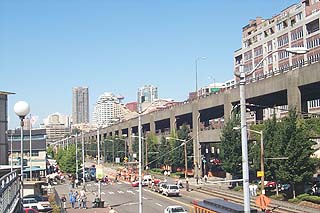|
Subscribe / Renew |
|
|
Contact Us |
|
| ► Subscribe to our Free Weekly Newsletter | |
| home | Welcome, sign in or click here to subscribe. | login |
Construction
| |
 |
September 5, 2002
Stuck in traffic? We’ve got a plan
WSDOT

Photos by Jon Silver Highway 99 through Seattle, the Alaskan Way Viaduct, carries 110,000 vehicles a day, equivalent to one third of the trips taken on Interstate 5. Damage from the Nisqually earthquake raised concerns about replacing the viaduct and seawall. |
Traffic —- everybody agrees that it is the number one problem in the Puget Sound area. And aging infrastructure must be replaced, including the seismically threatened Alaskan Way Viaduct and 520 floating bridge, both approaching the end of their useful lives. The state Department of Transportation (DOT) has a strategy, developed with citizens, neighborhoods cities and counties, to improve the transportation system. It’s a plan that addresses what really matters:
The plan fixes the worst first and builds toward the future. We all have sat in traffic at Interstate 405 and Highway 167. We have crawled through traffic across the 520 bridge. We’ve raced across the viaduct in hopes the “big one” doesn’t hit until after we touch down on the other side. We’ve driven south on Highway 509 to avoid Interstate 5 and wondered why it ends at a city street.
All these highways need major upgrades or improvements. But where does one start on such a big job? Together with our partners we have identified critical first segments be built on all the major corridors. The specifics are highlighted later in this article.
We will keep moving. The Puget Sound region works together. What happens in the north affects the south and what happens in the west affects the east. That’s why the DOT is committed to keeping all of the Puget Sound moving forward.
Improvements will be made as rapidly as possible to ensure that benefits are experienced throughout the region. At the same time, construction will be carefully coordinated to minimize disruption to travelers.
Balanced investments are critical. Building more roads alone will not solve congestion. It’s part of the answer, but alternatives are also needed. That’s why the DOT will also invest in a range of flexible transportation options. In each corridor, creative ideas to manage transportation demand and conserve capacity are integral to the plans.
Enhance environment and quality of life. We live here for a reason. We enjoy our fresh air, beautiful shorelines, and wide open spaces. As we make much needed transportation improvements, we are committed to leaving the environment better than we found it.
Impossible, you say? The less time cars sit in traffic idling their engines, the less air pollution we breathe. Stormwater will be treated before returning to the environment. Wetland areas will be restored.
Specific plans
Working with our partners, WSDOT has identified plans to significantly improve I-405, Highway 520, Highway 509, and the Alaskan Way Viaduct. These plans include two parts: long-term visions for the future and critical segments that must be addressed first. They include:
The long-term vision for I-405 includes adding up to two lanes along the corridor and investing in a bus rapid transit system.

The state DOT is investing in a range of flexible transportation options that will encourage commuters to leave their cars at home. The state ferry system includes passenger-only options on routes from Seattle to Bremerton and Vashon Island, and multimodal stations are planned for Anacortes and Mukilteo. |
We have a plan for the system, and we have a road map for moving forward with a significant first step. Making the Puget Sound region move forward — in balance — will take all of us to commit to a better future. The DOT is ready to build that balanced plan.
David Dye is the urban corridors administrator for the Washington State Department of Transportation.
Other Stories:
- Puget Sound ports get that sinking feeling
- Tough choices ahead at the ballot box
- Engineers support Referendum 51
- A pitch for the monorail


